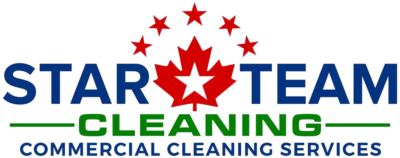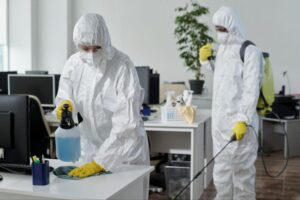Welcome to Star Team Cleaning’s comprehensive guide dedicated to the meticulous upkeep of kitchens and restaurants across the Greater Toronto Area (GTA), Canada. In the bustling culinary scene of GTA, maintaining impeccable cleanliness is not just a preference but a necessity. This guide aims to equip kitchen owners and restaurateurs with the knowledge and strategies necessary to uphold the highest standards of hygiene, ensuring both the safety of patrons and the reputation of their establishments.
Setting the Stage: Understanding the Importance of Cleanliness
- The Role of Cleanliness in Food Safety: Cleanliness in a kitchen or restaurant setting is paramount to ensuring food safety. Bacteria, pathogens, and cross-contamination can thrive in unclean environments, leading to foodborne illnesses and health hazards for customers.
- Impacts on Reputation and Customer Experience: A clean and hygienic environment not only promotes customer confidence but also enhances the overall dining experience. A positive reputation for cleanliness can attract and retain customers, contributing to the success and longevity of your establishment.
- Compliance with Health and Safety Regulations: Adhering to strict cleanliness standards is not just good practice; it’s also a legal requirement. Health and safety regulations mandate the maintenance of clean and sanitary conditions in food service establishments to prevent health risks and ensure public safety.

Preparing for Success: Essential Supplies and Equipment
- Checklist for Cleaning Supplies: Stock up on essential cleaning supplies such as disinfectants, detergents, sanitizers, degreasers, sponges, brushes, and microfiber cloths. Ensure that these supplies are readily available for daily cleaning tasks.
- Invest in Quality Cleaning Equipment: High-quality cleaning equipment, including mops, buckets, vacuum cleaners, steam cleaners, and floor scrubbers, can streamline the cleaning process and deliver superior results.
- Importance of Personal Protective Equipment (PPE): Provide your staff with appropriate personal protective equipment, including gloves, aprons, goggles, and face masks, to ensure their safety while handling cleaning chemicals and performing cleaning tasks.
Daily Cleaning Routine: Maintaining Hygiene Standards
- Start with Surfaces: Countertops, Tables, and Floors: Begin each day by thoroughly cleaning and sanitizing all food contact surfaces, including countertops, tables, and food preparation areas. Use a food-safe disinfectant to kill bacteria and pathogens.
- Sanitize Food Preparation Areas Regularly: Throughout the day, regularly sanitize food preparation areas, cutting boards, knives, and other utensils to prevent cross-contamination and ensure food safety.
- Clean and Disinfect Kitchen Equipment and Utensils: After each use, clean and sanitize kitchen equipment, appliances, and utensils to remove food residues and prevent the growth of harmful bacteria. Pay special attention to areas prone to grease buildup, such as grills and fryers.
- Proper Waste Management: Garbage Disposal and Recycling: Implement a waste management system to properly dispose of food waste, packaging materials, and other refuse. Separate recyclable materials from general waste and ensure that garbage bins are emptied and cleaned regularly.
Weekly Deep Cleaning: Going Beyond the Surface
- Thoroughly Clean Kitchen Appliances: Ovens, Grills, and Fryers: Schedule regular deep cleaning sessions to thoroughly clean and degrease kitchen appliances such as ovens, grills, fryers, and stovetops. Use specialized degreasers and cleaning agents to remove built-up grease and carbon deposits.
- Deep Clean Refrigerators and Freezers: Empty and defrost refrigerators and freezers regularly to remove ice buildup and food residues. Clean interior surfaces with a mild detergent solution and sanitize with a food-safe disinfectant.
- Degrease Exhaust Hoods and Ventilation Systems: Grease buildup in exhaust hoods and ventilation systems can pose fire hazards and compromise air quality. Schedule professional deep cleaning services to degrease and sanitize exhaust hoods, ductwork, and ventilation fans.
- Scrubbing Floors and Baseboards: Pay attention to floors and baseboards during weekly deep cleaning sessions. Sweep or vacuum floors to remove debris, mop with a disinfectant solution, and scrub baseboards to remove dirt and grime.

Tackling Tough Stains and Grease Build-Up
- Effective Solutions for Common Kitchen Stains: Identify common stains such as coffee, wine, grease, and food spills, and use appropriate stain removal techniques and cleaning agents to address them effectively.
- Removing Grease from Surfaces and Appliances: Grease buildup on surfaces and appliances can be challenging to remove. Use degreasing agents, steam cleaners, or vinegar solutions to dissolve grease and remove stubborn residues.
- Dealing with Stubborn Residue: Tips and Tricks: For stubborn residues and buildup, consider using abrasive cleaning tools such as scrub brushes, scouring pads, or razor blades (with caution) to loosen and remove the residue without damaging surfaces.
Maintaining Food Contact Surfaces: Best Practices
- Choosing the Right Cleaning Agents for Food Contact Surfaces: Select cleaning agents and sanitizers approved for use on food contact surfaces to ensure compliance with food safety regulations. Avoid using harsh chemicals that may leave behind toxic residues.
- Implementing Sanitization Procedures: Establish a regular schedule for sanitizing food contact surfaces, utensils, and equipment. Follow manufacturer instructions for dilution ratios and contact times to ensure effective sanitization.
- Ensuring Compliance with Food Safety Standards: Regularly monitor and document cleaning and sanitization procedures to demonstrate compliance with food safety standards during health inspections and audits.
Managing Staff Training and Accountability
- Comprehensive Training Programs for Kitchen Staff: Provide thorough training to kitchen staff on proper cleaning procedures, chemical handling, and safety protocols. Emphasize the importance of cleanliness and hygiene in preventing foodborne illnesses and ensuring customer satisfaction.
- Setting Clear Cleaning Protocols and Schedules: Develop detailed cleaning protocols and schedules outlining daily, weekly, and monthly cleaning tasks. Assign responsibilities to specific staff members and establish accountability measures to ensure tasks are completed efficiently.
- Establishing Accountability Measures: Implement performance reviews, inspections, and audits to monitor staff adherence to cleaning protocols and standards. Recognize and reward staff members who consistently maintain cleanliness and address any lapses or deficiencies promptly.

Outsourcing Professional Cleaning Services: When to Consider
- Benefits of Hiring Professional Cleaning Services: Professional cleaning services offer expertise, experience, and specialized equipment to deliver superior cleaning results. Outsourcing cleaning tasks can free up staff time and resources, allowing them to focus on core business operations.
- Factors to Consider in Choosing a Cleaning Service Provider: When selecting a cleaning service provider, consider factors such as reputation, experience, certifications, and pricing. Request references and conduct site visits to evaluate the provider’s capabilities and suitability for your establishment.
- Cost-Effective Solutions for Restaurants of All Sizes: Professional cleaning services offer flexible service plans and customized solutions tailored to the needs and budget of your restaurant. Compare quotes from multiple providers and negotiate pricing to ensure cost-effectiveness.
In summary, Maintaining a clean and hygienic kitchen and restaurant is not just a matter of aesthetics but a fundamental aspect of running a successful food service establishment. By implementing the strategies and tips outlined in this guide, kitchen owners



